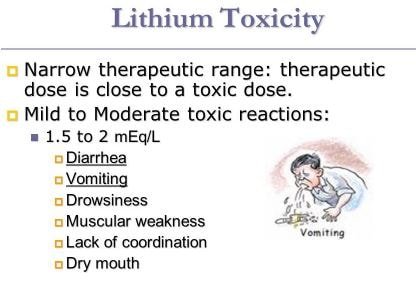Lithium Toxicity
Lithium Toxicity
Lithium has been used as medication since the 19th century. If this medication is taken in excess, the patient may suffer from lithium toxicity or overdose [1, 2}.
What is Lithium?
Lithium as a medication has been initially prescribed to patients who are suffering from neutropenia, gout and depression. The side effects that were associated with this drug can be fatal and it has been during the 1940s. It was used again as a medication in the 1970s as the management of the side effects have improved.
Presently, this drug is currently being used as a maintenance drug for people who are suffering from bipolar disorders. Taking lithium for a long time may cause changes in the morphology of the kidneys and lead to a decrease in renal function.
The required dosage of this drug is higher during the manic phase of the disorder and decreased once these symptoms have lessened [1, 2, 3, 4].
How much is Lithium Toxicity?
The therapeutic dose of lithium is set at 0.7-1.2mEq/L and the toxic dose anything greater than 1.5mEq/L. Toxicity may be classified as either acute or chronic. Acute lithium toxicity occurs as a result of taking in an increased amount of lithium.
Chronic toxicity, on the other hand, is the result of long-term lithium therapy. Even if an individual takes in the prescribed amount of lithium, conditions such as decreased renal function and dehydration may lead to the accumulation of lithium in the body and cause the toxicity [1, 2, 3, 4].
What are Lithium Toxicity symptoms?
The symptoms that will present depend on the type of toxicity the patient is suffering from. Symptoms from acute lithium toxicity include stomach pains, vomiting, nausea, dizziness and weakness.

These GI symptoms will be accompanied by neurologic manifestations depending on the amount of lithium that was taken. There may be tremors in the hand, muscle twitches, slurring of speech, eye movements that are uncontrollable, alterations in the level of consciousness and even coma.
Signs of chronic lithium toxicity are related to the failure of the kidney and effect on the nervous system. If the serum lithium levels are extremely high, the patient may present with uncontrollable tremors and disorders of movement and coordination [1, 2, 3, 4, 5].
What is Lithium Toxicity management?
The initial priority in the management of lithium toxicity is to maintain the stability of the patient. An impairment in the level of consciousness of the patient may lead in the alteration of spontaneous respiration. There may be a need to intubate the patient to maintain the respiration.
The serum level of lithium is identified in order to assess the severity of the condition. Patients will undergo fluid therapy in order to increase renal function and facilitate the clearance of lithium.
The serum sodium level is maintained as well because hyponatremia is associated with reduced excretion of lithium. If these measures are not successful in lowering serum level of lithium, hemodialysis may be initiated in the patient [1, 2, 3, 4, 5].
How to prevent Lithium Toxicity?
The main way to prevent overdosing on lithium is to take the medication only as prescribed by the physician. Medication bottles at home should be properly labeled and kept of children’s reach to avoid accidental ingestion.
For those who are taking this drug due to bipolar disorder, regular follow-ups are essential due to the need to adjust the dosage depending on the phase of the disorder.
Renal function should be closely monitored as well to ensure adequate lithium clearance and prevent drug build-up [1, 2, 3, 4, 5].
References
- Lee, D. C. (2015, February 2). Lithium Toxicity. Retrieved from Medscape: http://emedicine.medscape.com/article/815523-overview
- Heller, J. L. (2015, October 13). Lithium toxicity. Retrieved from Medline Plus: https://medlineplus.gov/ency/article/002667.htm
- Drugs.com. (2016, March). Lithium. Retrieved from Drugs.com: https://www.drugs.com/pro/lithium.html
- Thomas, H. (2013, February 5). Lithium. Retrieved from Patient: http://patient.info/doctor/lithium-pro
- Nickson, C. (2016). Lithium Toxicity. Retrieved from Life in the Fast Lane: http://lifeinthefastlane.com/ccc/lithium-toxicity/
